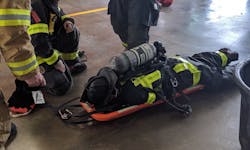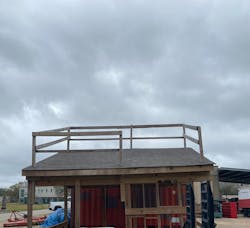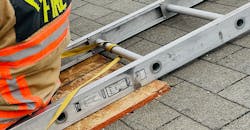Rapid intervention team (RIT) assignments are a vital part of fireground operations. An attentive and proactive RIT should focus on all aspects of fireground activities that can lead to its activation.
As a captain on one of the busier engine companies in a large metropolitan fire department, I routinely trained with members on RIT operations. Potential mayday situations were discussed, and all aspects of fireground activities seemingly were prepared for and evaluated. It wasn’t until I was promoted to truck captain that I realized that I previously continually under-evaluated and under-prepared, generally speaking, for a major fireground operation that occurs frequently: rooftop operations.
Not the same old thing
The core foundation of how firefighters perform usually begins with their competency in basic skills, and RIT operation ranks right up there with hose deployment and throwing ladders as a basic skill.
Furthermore, I believe that it’s easier for firefighters to adapt to and overcome difficult, high-risk/low-frequency challenges when they are competent in the basic skills.
When performing RIT training, there can be a tendency to become complacent in scenarios. Crews often carry out similar mayday drills time after time. This training often focuses on scenarios that involve interior operations and is conducted inside of apparatus bays, abandoned structures and/or training facility buildings. Undoubtedly, this training is crucial to building a strong foundation for any RIT, but very seldomly is any consideration given to crews who need rooftop rescue—despite the fact that Project Mayday indicates several mayday situations involved firefighters who fell through a roof.
Additionally, firefighters must become familiar with NFPA 1407: Standard for Training Fire Service Rapid Intervention Crews.
Training
In my department, we built training props so RITs can practice scenarios for rooftop operations. This included a pitched roof that offers access to a ventilation hole in the middle of the roof. Removable rafters were placed below the ventilation opening. An 8 x 16-foot roof prop that’s 10 feet off of the ground also was constructed.
These props provide members with the ability to train realistically on the rescue of firefighters who fall through holes, including developing techniques for rescue that’s based on how far that a member(s) fell and whether a member(s) is incapacitated.
We try to keep techniques and methods quick and simple, although this isn’t to say that more elaborate techniques, such as using webbing, don’t have their place.
That said, a firefighter who falls through a roof typically doesn’t call an immediate mayday nor does that person’s crew members, because initial actions usually are to begin self-rescue/rescue operations.Experience has shown that, first off, most firefighters resort to brute strength to complete a task that occurs in a time-sensitive or high-stress situation. Therefore, developing plans and techniques that appeal to this trait is imperative.
Firefighters should learn how to extract a firefighter who fell through a roof, based on whether the firefighter is waist-deep, chest-deep or head-deep in a hole.
RIT training also should include practice of proper hand placement under a fallen firefighter’s SCBA shoulder strap and arm, which allows the rescuers to use an effective mechanical advantage.
Practice placing a roof ladder in a ventilation hole is important, too, as can be the use of a 16-foot roof ladder as a fulcrum over the ridge of the roof, where the fallen firefighter grabs one end and the roof crew/RIT lay on the ladder to raise the firefighter out of the hole.
Because a mayday usually isn’t called by the roof crew or the firefighter who is in trouble, a well-trained and attentive RIT should be in position to recognize a mayday that occurs on the roof and to call the mayday when a roof division crew is observed in trouble as well as have a rescue plan in place if needed.
Training should consist of: paying attention to crews that are on the roof; providing a continual size-up of the structure; bringing the appropriate tools that might be needed for a rescue; and knowing how to efficiently and effectively deploy and operate your team and tools.
Training also should consist of integrating and communicating effectively with crews that are having a mayday.
Using ladders
Ground ladder and aerial ladder placement should be considered. Common practice is for truck crews to throw ladders on opposite sides of the roof. However, RITs should consider throwing additional ladders on stable areas of a roof to which downed firefighters could be pulled after removal from the hole that they fell in.
Most firefighters have trained on setting up two ladders side-by-side to rescue victims from an upper-level window or a roof or to carry a victim in an angled position without assistance from another member. RITs should consider different rescue techniques for an incapacitated firefighter.
The RIT should be prepared to slide a stokes basket down on an aerial ladder if there’s an area of the roof that can be accessed by an aerial.
Pay close attention to the design and construction of your equipment. Will the stokes basket fit on the last fly section of the aerial? Most stokes baskets are tapered, with the head being significantly wider than the bottom. Therefore, measuring the width of the stokes basket and the width of the fly section of an aerial is imperative. If the widest part of the stokes basket measures, say, 23 inches, fitting it between the last fly section of an aerial ladder that measures 22 inches will be problematic, particularly if it’s a metal stokes basket that provides no flexibility. Enter the18-inch-wide FAST board.
A FAST board is constructed uniformly in width from top to bottom. However, there are limitations to it. Firefighters must be secured to it, and the board can’t be slid down an aerial ladder as easily as a stokes basket can be. Also, lifting the board onto an aerial when a firefighter is attached might be a little more challenging than the same situation with a stokes basket, because, typically, only half of a firefighter’s body fits on the FAST board.
A bailout bag or webbing that’s anchored to a roof ladder also can be an option to a stokes basket.
In addition to knowing the length and setup of a bailout bag or webbing (and the associated hardware) and how to deploy it, firefighters should be familiar with identifying a good anchor point and practice lowering the incapacitated firefighter. (This equipment should meet NFPA 1983: Standard on Life Safety Rope and Equipment for Emergency Services.)
If using the ladder as an anchor point, firefighters should remember to attach the bailout bag carabiner (use rescue-rated carabiners) close to the foot of the ladder and to sit on the ladder to minimize swaying when the firefighter is lowered.
A significant training issue that should be scrutinized is the point of attachment on the firefighter for a carabiner. Understanding the design of PPE and its limitations are crucial for the safe and effective lowering of a firefighter. Hooking up to a rescue-rated harness is ideal.
The firefighter should be lowered feet first and face down to minimize the potential for injury and to allow the rescue team to take advantage of the natural mechanics of the human body.
Incident command
Officers could jump down the RIT rabbit hole further by training on the command aspect of a rooftop RIT operation.
In addition to the incident commander (IC), most agencies will assign an operations chief or a division officer at working incidents. Common practice has units move to a different radio channel, requesting additional resources and activating the RIT. However, does your agency practice the quick reestablishment of your respective incident command structure (ICS)? Is the RIT officer now your new operations/division officer during the mayday until additional officers arrive? Who now is the IC of the original incident, and is there an operations/division officer still in place?
Most agencies use some form of a formal ICS, such as NIMS or Blue Card. Firefighters, particularly officers, should have a good grasp of how the ICS structure will evolve should a mayday/RIT activation occur.
Additionally, organizations should include their respective dispatchers when conducting mayday training. Several agencies, particularly in rural areas, use their local law enforcement agencies, which aren’t fluent in fire department lingo and protocols, to dispatch the fire department. Consideration should be given to placing a member in the dispatch center to observe how dispatchers respond to a mayday, whether established standard operating guidelines (SOGs) are followed and what changes might be necessary. Including dispatchers in more fire-based training, teaching them fire service lingo and dedicating dispatchers to just fire department incidents might be viable options.
Mutual-aid companies should be included in training. Members should be familiar with a neighboring department’s mayday operation and SOGs, including how their dispatch centers operate. Many rural agencies only have two or three dispatchers on duty. Can that number of dispatchers handle a multichannel incident? If not, what is an agency’s viable option? Must they stay on the same tactical channel? Can additional fire and EMS calls be dispatched and operated off the police department’s tactical channel, so as not to interfere with the active incident on the fire channel? If not, what’s Plan B?
Anything but routine
In my experience, upon completion of this type of training scenario, the feedback usually is positive, and all of the firefighters are happy to have learned something that often isn’t discussed.
Several goals usually are accomplished. First, firefighters are educated about techniques that allow them to perform in an atypical training evolution. Second, everyone is trained on some core proficiencies, such as activating the emergency indicator button or calling the mayday. Third, rooftop RIT training keeps firefighters engaged and motivated, because it isn’t “routine RIT training.”
I understand the reality of not being able to train for every situation. However, it’s important to at least have a plan for the core fireground assignments. As we all know, it’s easier to change a plan when you have a plan.
Greg Obert
Greg Obert is a 22-year veteran of the Houston Fire Department. His rank is senior captain. Obert also is a program coordinator at College of the Mainland for the fire technology program. He holds a Bachelor of Applied Arts and Sciences in emergency management administration from West Texas A&M University and an associate of applied science degree in fire protection technology from San Jacinto College. An executive board member for the Texas Association of Fire Educators, Obert holds certifications as a Master Firefighter, Instructor III-Master and Fire Officer IV.








